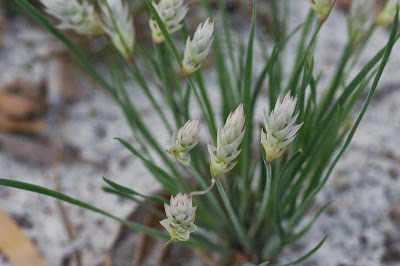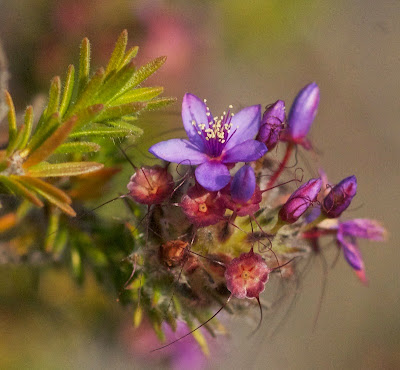Everywhere we looked, the Kwongan - the sandplain heath vegetation that covers most of the park - was heavily in bloom.
The road verges were particularly good places to look for flowers, perhaps because there were no bushes to crowd them out.
Granny Bonnets (Isotropis cuneifolia) were blooming in numbers along the roadside...
... as were the local versions of Milkmaids, in this case Burchardia congesta.
The Goodeniaceae added their blue and yellow flowers to the bouquet: Blue Leschenaultia (Leschenaultia biloba)...
and at least two species of Hibbertia.
Clusters of coneflower buds sprouted out of the sand. This one is probably Golden Conostylis (Conostylis aureus).
Among the coneflowers are the delicate shoots of Pipe Lily (Johnsonia pubescens), a member of the daylily family (Hemerocallidaceae). They don't look much like lilies (or daylilies, for that matter), and in fact the five species, all confined to the southwest, they have been shuffled about among a number of plant families.
Pipe lilies are peculiar, if beautiful, plants. The most obvious things on their flower heads are not flowers at all, but colorful bracts ranging from white to deep pink. The flowers themselves, which you can see in the middle photograph above, are tiny, and more or less completely concealed by the bracts. Besides, although these plants have leaves, most of the green grassy objects that do the photosynthesizing are stems modified to take over the true leaves' function.
Pepper and Salt (Philotheca spicata) is a shrubby member of the rue family (Rutaceae). Why it is called Pepper and Salt I have been unable to ascertain.
The small white object that we are all staring at in this photograph is a Posy Triggerplant (Stylidium crossocephalum), and I am trying to demonstrate its trigger mechanism. As so often happens when you are trying to show something to somebody else, the plant refused to cooperate.
Nonetheless, the Posy Triggerplant, even if uncooperative, is still (to my eye) one of the showier members of its family.
As always, there are plants that I can't identify even to family. I am posting them here in the hope that some future botanist will read this, and come to my rescue.
In any case, eucalypts are scarce in the largely treeless Kwongan. instead, myrtles form a large part of the dense heathland shrub layer. Many have flowers like these, making them difficult for identification from photographs. This one could be Geraldton Wax (Chamaelaucium uncinatum) or possibly Large-flowered Baeckea (Baeckea grandiflora).
The large genus Darwinia was not named for Charles Darwin, as you might expect, but for his almost equally remarkable grandfather Erasmus (1731-1802). Accordng to Wikipedia, Erasmus was a physician, natural philosopher, activist against the slave trade and poet. His long and rather peculiar poem The Loves of the Plants (1789) treats pollination as though the flowers were characters in a romance novel, and his last poem The Temple of Nature (published after his death in 1803, but long before his grandson wrote The Origin of Species) sets out his own ideas about evolution:
" ...as successive generations bloom
New powers acquire and larger limbs assume;
Whence countless groups of vegetation spring,
And breathing realms of fin and feet and wing."
Anyway, the genus is entirely Australian, and the majority of Darwinias are confined to the southwest. The red flower clusters creeping along the ground n this photo could be Murchison Darwinia (Darwinia virescens), though by rights that species should be further north, around Geraldton.
The clawflowers (Calothamnus) are found only in the southwest, but they are common there, and widely planted on roadsides (for good reason; their name means "beautiful shrub"). There are many species; this one is Common Net-bush or One-sided Bottlebrush (Calothamnus quadrifidus), one of the most widespread species in the genus.
This appears to be the much more localized Long-leaved Clawflower (Calothamnus longissimus), confined to the Kwongan between Geraldton and Perth.
Like the proteas we looked at last time, myrtles are very diverse in flower form. You'd have to be a botanist to understand why starflowers (Calytrix) are in the same family as the clawflowers. There are many species; this appears to be the widespread southwestern species Calytrix leschenaultii.
These may be the much more localized Calytrix oldfieldii, though I am far from sure. not all starflowers are purplish; there are pink, white and yellow-flowering species as well.
A number of myrtles, including the eucalypts, have flowers dominated by clusters of colourful stamens. They include the more than 300 species in the genus Melaleuca, the paperbarks or honey-myrtles. Outside of Australia the best-known is the Paperbark Tree (M. quinquinerva), which has become a serious invasive pest in southern Florida (and elsewhere). This appears to be Melaleuca urceolaris, one of the shrubby species.
There are a number of purple-flowering melaleucas, but I believe this to be Violet Eremaea (Eremaea violacea), a member of a much smaller genus confined to Western Australia.
Sticky Eremaea (Eremaea beaufortioides) is a local species confined to the Kwongan country near Lesueur.
Certainly the most arresting of the myrtles at Lesueur are the featherflowers of the genus Verticordia. There are over 100 species, most of them confined to the southwest, and Lesueur boasts a large and showy assortment. Their sepals form a colourful fringe just below the petals, a feature responsible for their common name; their overall beauty is surely the inspiration for their Latin name Verticordia, which means "heart turner".
Identifying the array of featherflowers to species is, with some exceptions, beyond my skills, especially when the flowers (as here) are not fully open.
Most verticordias are adapted for pollination by bees, though flies, beetles and (for some species) birds are also involved.
Here is one that I think I can safely identify: the widespread Yellow Featherflower (Verticordia chrysantha). There are some even more colourful ones coming in my next post - my final one on our drive through Lesueur National Park - so stay tuned!




%2BDSC_1971.jpg)
%2BDSC_1972.jpg)

%2BDSC_2011.jpg)

%2BDSC_2016.jpg)



%2BDSC_2000.jpg)
%2BDSC_1996.jpg)
%2BDSC_1999.jpg)

%2BDSC_1997.jpg)

%2BDSC_1843.jpg)

%2BDSC_1961.jpg)
%2BDSC_1963.jpg)
%2BDSC_1967.jpg)



%2B%2BLarge-flowered%2BBaeckea%2B(Baeckea%2Bgrandiflora)%2BDSC_2030.jpg)
%2B%2BLarge-flowered%2BBaeckea%2B(Baeckea%2Bgrandiflora)%2BDSC_2027.jpg)
%2BDSC_2007.jpg)
%2BDSC_2180.jpg)
%2BDSC_1860.jpg)








%2BDSC_1816.jpg)
%2BDSC_1895.jpg)







%2BDSC_2044.jpg)
%2BDSC_2046.jpg)